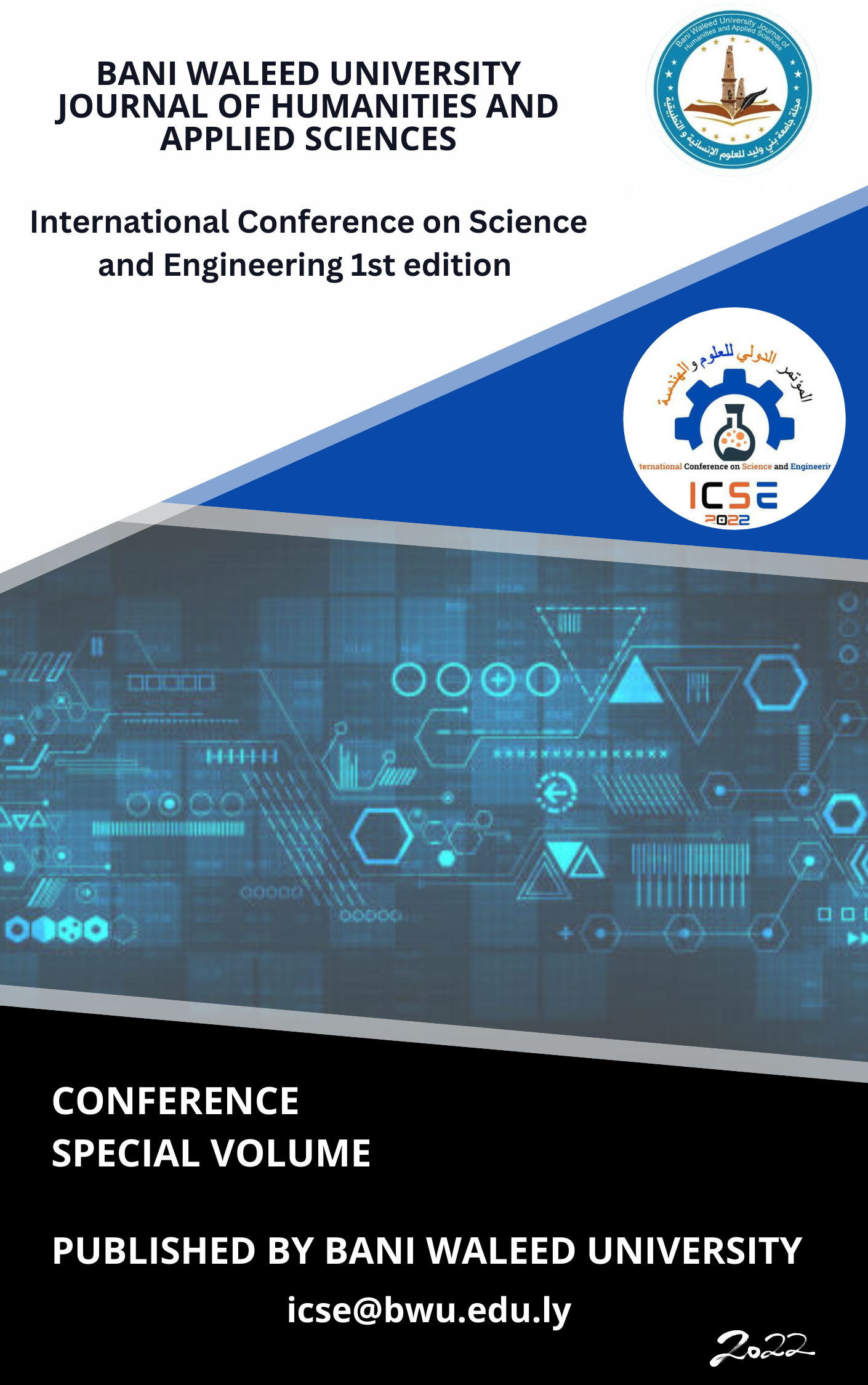Radiological assessment of cancer risk and Human Health Risk in Bani Waleed city, Libya
DOI:
https://doi.org/10.58916/jhas.v7i6.591الكلمات المفتاحية:
الانجليزيةالملخص
Abstract: Under specific circumstances, the natural radioactive 226Ra, 232Th, and 40K materials can reach dangerous radiological levels. As a result, research on the levels of natural radioactivity in soil is required to estimate the dose to the population, analyze the health risks, and establish a baseline for potential future changes brought on by human activity.
Hyper-pure germanium (HPGe) gamma ray spectrometry was utilized to examine three sites in Bani Waleed, Libya, in order to determine the radiological health risks, excess lifetime cancer risks, and Effective Dose to Different Body Organs (Dorgan) associated with the use of the soil. Nine samples were collected from each of the three sites (Tagrafeet, Sakia, and City Center) at a depth of ten cm, measured and use an HPGe detector, and the results were compared to the global permissible value. The excess lifetime cancer total, both indoor and outdoor average values were lower than the world permissible value, and the results of all different body organs were below the accepted international limits of 1.0 mSv-1, indicating that the radiation levels in the study area are safe and do not pose a health risk to the local population. The results of this research could serve as significant radiometric baseline data for upcoming epidemiological investigation and prosecution and environmental monitoring programs.
التنزيلات
المراجع
Belivermis, M; Kilic, N; Cotuk, Y;
Topcuoglu, S., (2010).The effects of physicochemical properties ongamma emitting natural radionuclide levels in the sol profile of Istanbul, Environ Monit Assess.
(1-4): pp 15-26.
UNSCEAR (2000). United Nation Scientific
Committee on the Effects of Atomic Radiation.Sources and effect of Ionizing radiation. Report to the general assembly with scientific annexes. United Nations; New York.
Avwiri GO; Enyinma P; Aghalagba EO. (2010). Occupational Radiation Levels in Solid Mineral Producing Areas of Abia, State. Nigeria Scientia Afericana, Vol. 9 (No. 1), pp 93-97.
Steinhausler, F. (1992). The natural radiation environment: future perspective. Radiation Protection Dosimetry, 45,19-23.
Karahan, G. and Bayulken, A. Assessment of gamma dose rates around Istanbul (Turkey ).J.Environ. Radio act.47, 213-211 (2000).
Deger lier, M .,Karahan, G.and Ozger,.
(2008). (Radioactivity concentrations and dose assessment for soil samples, around Adana, Turkey. J. Environ. Radio act. 99, (6),1018-1025.
Kannan, V., Rajan, M .P, Ly enga A. and Ramesh, R., (2002).Distribution of natural and anthropogenic radionuclides in soil and beachs and Samples of Kalp akkam (India). App l.Rodiat. Isot.57,109-119.
Debertin, K., & Helmer, R.G., (1988).
Spectrometry with semiconductor detectors. North-Holland Amsterdam.
Amrani, D., & Tahtat, M. (2001). Natural
radioactivity in Algerian building materials.
Applied Radiation and Isotopes, 54, 687-689.
Darwish DAE; Abul-Nasr KTM; El-Khayatt AM (2015) The assessment of natural radioactivity and its associated radiological hazards and dose parameters in granite samples from South Sinai, Egypt. Journal of Radiation Research and Applied Sciences 8, 17- 25.
Qureshi AA; Tariq S; Din KU; Manzoor S;
Calligaris C; Waheed A (2014) Evaluation of Excessive lifetime cancer risk due to natural radioactivity in the rivers sediments of Northern Pakistan. Journal of Radiation
Research and Applied Sciences, 7 (4): 438-447.
.
Ravisankar,R.,Sivakumar,S.,Chandrasekaran ,A.,Prince Prakash Jebakumar, J., Vijayalakshmi,I., Vijayagopal, P., et al. (2014). Spatial distribution of gamma radioactivity levels and radiological hazard in dicesin the east coast sediment of Tamilnadu, India with statistical approach. Radiation Physics Chemistry, 103, 8-98.
ICRP 106. (2008). Radiation dose to patients from radio-pharmaceuticals. Addendum 3 to ICRP Publication 53. ICRP Publication -106. Ann. ICRP 38, pp.1-2.
International Commission on Radiological
Protection (ICRP), International Commission on Radiological Protection Age-dependent Doses to Members of the Public from Intake of Radionuclides. Part 5, Compilation of Ingestion and Inhalation Coefficients ICRP Publication 72, Pergamon Press, Oxford, 1996.
Ramasamy,V.Suresh,Meenakhisundaram,v.
and Gajendran, v.,(2009). Evaluation of natural radionuclide content in river sediments and excess lifetime cancer risk due to gamma Radioactivity. Research journal of environmental and earth sciences, vol. 1, no. (1), pp. 6-10.
Taskin, H., Karavus, M., Topuzoglu, P., AY, A., Hindiroglu, S. and Karahan, G. (2009),
Radionuclides concentrations in the soil and lifetime cancer risk due to gamma's radioactivity in kirklareli, Turkey. Journal of environmental radioactivity, vol. 100, no. 1,pp.49. Doi:10.1016/j.jenvrad.2008.10.012.
Agbalagba OE (2017). Assessment of excess lifetime cancer risk from gamma radiation levels in Effurun and Warri city of Delta state, Nigeria. Journal of Taibah University for Science 11(3): PP.367-380.
Ugbede FO; Benson ID., (2018). Assessment of outdoor radiation levels and radiological health hazards in Emene Industrial Layout of Enugu State, Nigeria. Int. J. Phys. Sci Vol. 13 (20), pp. 265-272.








